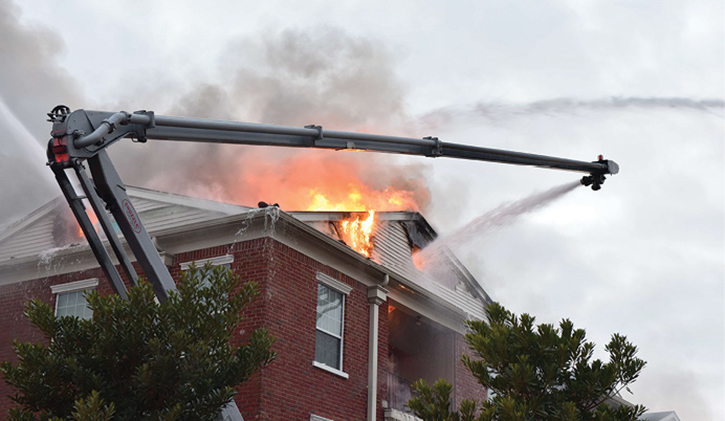
Can you survive falling through the roof? Falling through the roof is the third leading cause for calling a Mayday, according to Don Abbott’s Project Mayday. You are working above a fire and standing on building materials that are weakened or decaying from heat and fire buildup and environmental impact—lightweight building materials that have not been maintained or inspected—and you find that weakened spot and fall through the roof. Are you wearing all your proper personal protective equipment when operating on a roof? What are your department’s standard operating procedures for working on a roof to perform rooftop ventilation? How often does your department allow you to climb onto a roof to practice using portable ground ladders and saws and axes to open up and cut a hole in the roof safely? If you fell through the roof, can you escape and get out alive?
This is my (Zeigler’s) story of working on the roof of a three-story senior citizen complex when I fell through the roof into an attic space that was fully involved in fire. My options were few; my decision process had to be quick while under the most pressure I had ever faced.
RELATED FIREFIGHTER TRAINING
Entering Through the Door, Falling Through the Floor: Catastrophic Structural Collapse
Floor Collapse: A Survivor’s Story
The Incident
On Saturday, February 2, 2019, I thought it was going to be just another day at work. I was assigned to my normal firehouse, Jefferson Parish (LA) Fire Department Station 18 Engine 188. I had coffee in the morning and talked with the members of my on-duty crew. We did our housework and ran some errands. In the late afternoon, I was shopping for the evening meal when we received a report of a fire in a senior citizens complex in our town. As I got back to the firehouse, we were dispatched on the second alarm.
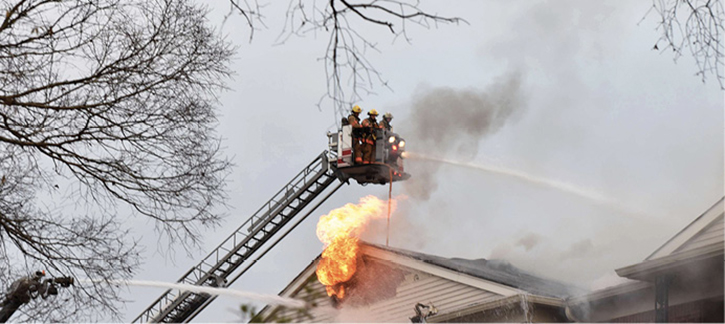
(1) Jefferson Parish Ladder 117 applies a master stream to the heavy fire conditions in the attic of a three-story structure. (Photos 1-3 by Chris E. Mickal.)
As we were responding, we heard radio traffic reporting a smoke condition on the interior of the three-story complex but did not hear that the fire had been located. Command reported he needed personnel to help with the evacuation of the many residents who lived there.
Once on scene, my officer, Lieutenant Jeff Patureau, took the other firefighter and reported to command as the driver and I stood by our rig waiting for an assignment. We looked at the attic area and saw smoke puffing from the eaves and noted the roof needed to be opened. As Chief Carl Brondum passed by our rig, we asked if he wanted us to open up the roof, and he acknowledged that it would help because it was now determined that the fire appeared to be in the attic and a hoseline was being deployed there from an interior stairway.
The chief directed us to work with Ladder 117, a rear-mount ladder tower with a bucket, which was on the C/D corner of the building. He sent me to the roof with Firefighter John Farrelly. When we made the roof, we positioned the bucket on the ridge.
Once I exited the bucket and stepped onto the roof, I checked the stability of the roof; it appeared solid where I was standing. I also checked the slope of the roof and it was an easily walkable roof, not requiring an additional roof ladder to climb up and down. I walked the ridge to the D side of the roof and began venting with a pike pole. From the roof, I yelled down to the driver operator of Engine 148, who was operating a high-reach extendable turret. I advised we needed water.
I then looked for an area on the roof to make my first hole. The peak looked like a good place to start, so I made a three- × two-foot hole. At this time, my partner was also cutting a vent hole. A third firefighter brought up a chain saw to the roof.
Once I made my first hole, smoke was coming from it, so I made a second hole of the same size nearby. Again, more smoke rose from the opening. At this point, the saw on the roof stopped running, and the firefighter operating it was trying to figure what was wrong with it. I continued my size-up of the roof by walking across the roof toward a raised wall section to see if this was a fire wall. This allowed us to check conditions and plan where we were going to open up the roof for further ventilation.
As I placed my right foot down, it sank about three inches into the roof. My left foot then sank about six inches into what was becoming a soft, spongy, unstable roof. My first thought was, “I have to get off of this spot because it is going to collapse.”
Mayday: Firefighter Fell Through Roof
Suddenly, a 12- × 12-foot section of roof dropped, causing me to fall into the now well-involved attic space with fire below me. My partner saw me fall through the roof and yelled to Lieutenant Todd Wakefield, who had just climbed up to the bucket and was going to join us on the roof, to call on the radio for a Mayday: A firefighter fell through the roof.
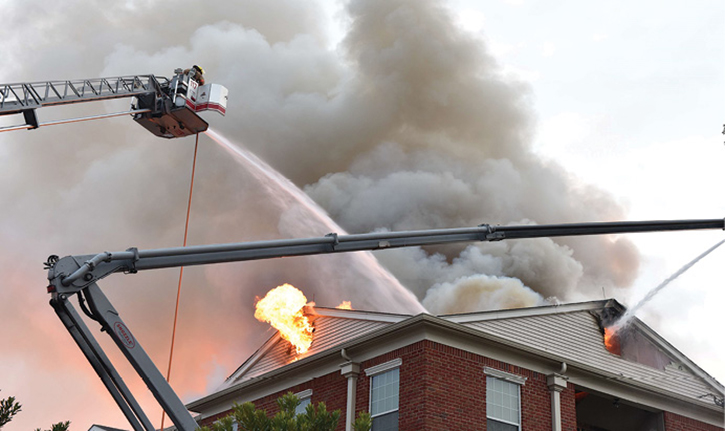
(2) Ladder 117 operates a master stream into a collapsed portion of the roof and Engine 148 directs a master stream into the roof vent opening in the attic space. This photo was taken after the Mayday was secured, showing fire conditions in the attic.

(3) Engine 148 directs a master stream into the roof vent area. This photo was taken after the Mayday was secured, showing the fire conditions in the attic.
As firefighters heard the distress call go out over the radio, they wondered where I fell into the attic space, as this was a very large building with a long distance to cover. As I fell into the attic, I landed on all fours and a section of the collapsed roof that, to some extent, helped block some of the flames around me but not all.
Seeing fire all around me, I quickly realized I had to get out of there. I did not feel any pain even though my helmet came off when I fell and my head was burning. It was a hyper crazy feeling: wanting to do something, knowing what to do, but second-guessing myself. As I looked left and right, up and down, it was all fire. I did not have my mask, so I started to inhale heat that was burning.
Every breath got hotter and hotter. At one point, I thought I could get out the hole or section of the roof I was standing on because I could see the blue sky through the smoke. I even thought I could jump and I would get to safety. But every time I tried to grab for the roofing material, it slipped through my hands—I could not get a hold of it. As I was trying to reach up for the roof section, my fire coat was riding up my back and exposing my T-shirt underneath to the heat, burning my back with third-degree burns for that short time it was exposed.
The personnel on the roof could only see flames and smoke coming out of the roof where I once stood and deemed it too dangerous to try to go where I was once standing.

(4) Zeigler before the fire on February 2. (Photos 4-7 courtesy of authors.)
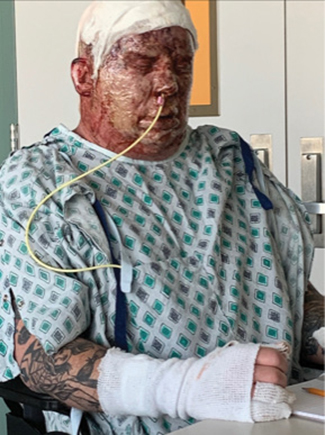
(5) Zeigler several days after being admitted to the University Medical Center with severe burns covering more than 30% of his body.
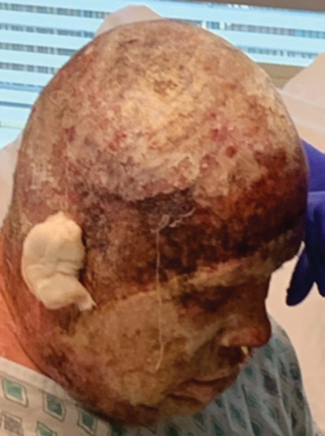
(6) The severe head burns.
I felt the fire starting to get the better of me, so I had to make a quick decision: Go left? No. Go right? It was confusing. If I crawled, I would run into the walls of the roof. While standing, my knowledge of building construction came to mind: Punch through the floor, which was drywall, and I could get into the apartment below me. So, with my left foot, I gave a mighty kick, which started to open up the ceiling below me. Now I just had to get through the rafter space. As I tried to get through that narrow space, I must have jumped up to get a better position between the rafters and struck my head. That force caused me to fall, landing on the floor of what was a third-floor apartment master bathroom.
This was the apartment where the original 911 call reporting the smoke came from. It appeared that the apartment was occupied by a resident who had her blind son staying with her. Since it was late Saturday afternoon, she decided to go to church and he chose to stay home. While she was at the church service, the son smelled smoke. Not really sure where it was coming from, he called his mom on her cell phone to tell her what was happening. She left the church and drove home to see what was going on. This resulted in at least a 45-minute delay in reporting the fire from the onset of smelling the smoke.
I believe I was unconscious for a brief time. I was laying on what was the bathroom floor, which felt like I was waking up from what I thought was a bad dream. I awoke to pain in my head, face, back of the neck, and chest. But then I realized it was not a dream: The room I was in was a smoky environment where I could see flames above my head, and I knew I had to get out of there.
I also realized I could not see. This was from the heat exposure to my face. I attempted to get up and found a wall that I had to feel my way to; it led me to the apartment hallway, which had a very thick smoke condition. I tried opening my eyes and I briefly saw the back of a self-contained breathing apparatus (SCBA), which was not too far from where I was standing. What a relief. I remember hearing loudly a firefighter saying, “WE GOT HIM.” Lieutenant Billy Hass started talking to me at the same time and patting my head—what was left of my hair was still on fire. I closed my eyes again, and all I remember was the commotion of several firefighters trying to carry and drag me to get me down lots of stairs outside to the ambulance.
They later informed me that the Mayday lasted 1 minute 10 seconds from the time it was called to the time they reported finding me.
Once in the ambulance, I do not remember much. At some point, I opened my eyes and sitting on my left side was Hass, who was trying to talk to me and tell me everything was going to be OK. When we were talking, he grabbed my hand and saw that my hands were steam burned and the skin was hanging off them. The paramedic who was treating me informed me that he had to put me out because he had to intubate me before my airway closed off. And that is all I remember.
Devastating Injuries
While in the hospital the first week, I was heavily medicated. I was sitting up and walking some. All I remember after being admitted to the hospital was my brother Matt trying to talk to me. My good friend, Detroit (MI) Fire Department Lieutenant Leo Spitzig, traveled from Detroit to be with me and my captain, Todd Roser, was there with me as well. But apparently, I was trying to talk to all those who came to visit me. I was able to walk to the family waiting room, where I met with family and fellow firefighters for short periods of time.
I was first being treated by trauma doctors who were trying to come up with a game plan for me to survive these devastating injuries. Then, I was assigned to Dr. Jeffrey Carter as my burn surgeon. He reviewed the damage done to my body and internal system and reviewed my test results. I was given a 13% chance of survival.
My family and friends were devastated. My family had thought about having to start making final arrangements. The Parish Fire Department had started contacting the Honor Guard to make plans for my funeral. I had suffered third-degree burns to my face, hands, neck, and back, but my most severe injury was to my lungs. I had a Grade 5 inhalation injury, which is as bad as it gets. I was placed on a feeding tube, using my nose to deliver my nourishment. I had been diagnosed with severe burns to more than 30% of my body. I was diagnosed with pneumonia, MRSA, cyanide poisoning, and carbon monoxide (CO) poisoning; my kidneys had shut down; and I had three broken ribs.
I was later informed by Dr. Carter that had I been exposed to any more cyanide and CO, I would not have made it. I was like a sponge full of these chemicals. I absorbed more than the human body can absorb.
The hospital I was taken to was University Medical Center (UMC) in New Orleans, a Level I Trauma Center capable of treating patients with my type of injuries. The burn center had been open for less than a year. Prior to this hospital being built, I would have had to have been air lifted to Houston or Tampa to another Level I Trauma Center. The doctor advised me I would not have survived the trip to any of the other locations. UMC was built by the federal government in conjunction with the new VA Hospital after the issues that took place when Hurricane Katrina struck the area long before I had moved there.
To clarify, I came to the hospital unable to breath without a plastic tube down my mouth inflating my lungs. After two days, I was extubated and breathing on my own. I thought this was the end, but this was only the beginning of my recovery for my inhalation injury because I got severe pneumonia. The pneumonia develops after the soot and ash in your lungs corrode the lining of your lungs and block your airway.
I was put back on the ventilator and then placed in a coma. This gave my body time to start the healing process. My eyes rested so they were getting better so I could see again. In this coma, I really experienced no pain (normally burn victims have to experience the pain of cleaning the dead skin to make it possible for the new skin to grow back).
There was concern that I might lose the tip of my nose and both of my ears because of the burns they received. Medical staff had to use swabs to rub off the scabs that had formed and clean those areas so more scabs could form, to be removed again. The more the scabs grew, the smaller that area got. After aggressive treatment by the medical staff, I was able to keep my ears and nose.
I had three surgeries during this time. One was on my hands to apply skin grafts where the skin had burned off. There were five other bad spots that required sewing the skin back on.
New Treatment
The staff repaired the skin on my hands and face with a new technique involving taking stem cells from my unburned skin and spraying them on my face and hands using a kit call Avita Recell. After five months, this helped regenerate skin on my fingers and produced my fingerprints. There was a surgery to repair the burned skin to the lower half of my face and another one to repair the upper half of my face and forehead. Apparently, I was the first adult in the country who had the Avita Recell spray skin applied to my full face, which had a full-depth third-degree burn.
During this time, doctors said I showed some improvement but also showed further decline in my condition. At one point, Dr. Carter had turned the knob of the ventilator to the last click, meaning he was out of options to keep me alive. So, he started to contact additional doctors in his field across the country and found a new idea to try on me. Since I had been lying on my back so much, his research had found that proning me might help move the fluid in my lungs. They had to paralyze me so every six hours they could turn me over from lying on my back to lying on my stomach.
After two weeks, I was awakened out of my coma, but it took time to fully wake up. This was when I met my doctor for the first time: This big guy stood over me and I said, “Who the hell are you?” It was hard to talk, as my throat was very sore. I had tubes coming out of me, but I did not know why. I could not remember what happened to me. All I wanted to do was go back to work. I thought I could be back in about a month.
But reality set in. My rehab started with the medical staff wanting me to start to get in and out of bed and sit up in a chair. I did this several times a day until they said okay, now let’s walk. I could not take too many steps because when they paralyzed me, I lost 50% of my muscle mass and had to start rebuilding it. So, I started by walking 15 steps, then 30, then 60. Before I knew it, I was able to climb up and down the hospital stairways. As a treat, I was allowed to walk outside.
I met with a psychologist who wanted to evaluate me because of the trauma I sustained but I felt I did not need her as much as my family did for what I had put them through.
After three weeks, I had another surgery to continue repairing the burns to my forehead. I was being fed 4,500 calories and 160 grams of protein a day through a feeding tube. My doctor told me this amount of energy required to repair my body was the same as that required to run a marathon. So, every day it was the same.
The last week in the hospital, I had to prepare for going home; I had to learn how to clean the top and back of my head. After my shower, I had to learn how to apply a medicine to a washcloth and start cleaning my burns. This was extremely painful. The skin I burned away had now regenerated one layer of skin, and that was still touching the nerve endings that were starting to grow back. The human body has many layers of skin; I had a long way to go.
I was admitted to the hospital on February 2 and released on March 29—eight weeks after the fire. After the feeding tube was removed, I was not eating like they wanted me to because I was nauseous from trying to eat and not maintaining the correct level of protein for my body.
When I got home, I was so thankful to be home again but, living alone, I had to learn things all over. My family, my really close friends, and my fellow firefighters came to visit along with my former Marine Corps buddy that I served with in Japan. All these wonderful folks helped to make my transition possible.
The doctor sent me home early. I should have stayed in the hospital for four months; I only stayed for two. This was in large part because of the new product that helped my burns heal more quickly. My doctor wanted me to do two major things: (1) take care of my burns/clean them and be able to take care of myself if no one was there to help me and (2) be able to walk by myself.
When I took my showers, usually in the evening, I had to have some help cleaning my burns. I had to apply a medical soap on the washcloth and clean those wounds. I then had to apply ointment to the burns, a steroid wrap, and some surgical dressings. This process every night took about a half hour.
I got to rest at home and get some good sleep, eat again, and watch some television. I started to heal better and build up my strength. I had to go to rehab to help build strength and go to follow-up visits with Dr. Carter. I started driving to those by myself against the advice of the doctor. So, my home life was now eating, housework, and cleaning myself—that is about all the energy I had after all that work.
It had been a challenge to eat, as I’d get nauseous. I had five surgeries—some for plastic surgery on my ears, cheeks, nose, and upper lip. A third of the hair on my head did not grow back after the fire, so I had laser hair removal and an eyebrow transplant. A year after the fire, when COVID-19 hit, all my trips to the hospital stopped, so I had to wait to go back for further treatments and surgeries.
Today, if you ask me how I feel and if I have any pain, I can say that the skin on my face is tight. It feels like I am wearing a Halloween mask that is stuck to my face 24/7; my face feels like I have a sunburn.
Every month I get better. My skin is regenerating, and it takes time to heal. Resting helps build up my stamina, and the nausea is not as bad as it was before.
As I write this, it has been one year and several months since the fire. I still have to come to grips with whether I will continue as a firefighter or will have to go on medical disability. It has been hard to deal with the full-depth facial burns to my skin.
Lessons Learned
What can I share with you about this incident? As I continue to recover from my injuries, I think about what actions I took to get in trouble and what actions I took to get out of danger.
With my previous job, I had been to several hundred fires on a regular basis. With my current job, I had only been to a few fires in the past few years. Did the lack of fire duty lower my guard and make me complacent?
My knowledge of building construction made me do what probably any other firefighter would have done with no smoke showing while on the roof except from the eaves. When I fell into the attic space, however, my knowledge of building construction was a deciding factor in my survival.
Every second counts. I had a split second to make a decision, which could have been the difference between my life or my death to get out of an inferno that was burning me up. When you are on fire, your training is not going to work at this point. My pure survival instincts kicked in: It’s fight-or-flight time.

(7) Zeigler on his first visit back to the firehouse just 10 weeks after the incident.
When I fell into that attic space, that floor I was standing on was the key to my exit. I tried to exit the roof from where I fell through, but the height was too great to exit from that point, and the melting roofing material I grabbed onto fell apart. Dropping through the drywall ceiling would be my door to a safer environment. Self-rescue—you hear about it, you read about it, but when it came time to make a decision, I had no choice, no time to act while waiting for others to come help me out. I had no time to even call a Mayday.
What could I have done differently to protect myself from the injuries I sustained? Simple: Wear all my protective gear.
I had only one option, and that was to survive. Stay low, stay calm—this is easier said than done. You have to visualize and practice for something of this magnitude to protect yourself the best way you possibly can. Look around at your surroundings. Protect your gloved hands from the superheated environment that could lead to severe burn injuries. Protect your mask face piece as best you can. Activate your personal alert safety system device so it can alert other crew members on scene as to where to locate and rescue you. Use your portable radio to communicate important information.
Some would say keeping on the SCBA is a must, but to exit this attic, I had to use a reduced-profile maneuver to get through the ceiling rafter space. In this case, I would have had to take it off to get through the rafters.
Training could increase your chance of survival whether you are a new recruit fresh out of probie school or an experienced firefighter who has seen it all. My entire life changed in a matter of seconds; your life could change or end just like that. I thought I was invincible. I was trained and equipped to fight fires and came to realize that things can go wrong in a hurry when you are doing your job.
Recreate events in training where firefighters have either been killed or injured so you can learn from them. Think what their options were and what you can do, if anything, to overcome what happened to them. Learn from others. What happens to you on the fireground affects not only you but those you work with as well as your family.
My life changed in the blink of an eye. To this day, having been severely burned has been an emotional ride with good days and bad days. The pain and the struggles are not only mine but also my family’s. I am still working with my fire department in hopes that one day I might be able to return to work, but again, only time will tell.
Danny Zeigler is a firefighter and a seven-year member of the Jefferson Parish (LA) Fire Department assigned to Station 18, B crew. Prior to joining the department, he was a firefighter for the Detroit (MI) Fire Department for 13 years.
David Traiforos, a 47-year veteran of the fire service, retired as the chief from the Franklin Park and Berkeley (IL) Fire Departments. He teaches at NIPSTA Training Academy, Glenview, IL; McHenry County College, Crystal Lake, IL; and, nationally, as the lead instructor of Great Lakes Fire & Rescue Solutions. He has been a HOT instructor and a presenter at FDIC International for more than 20 years.

